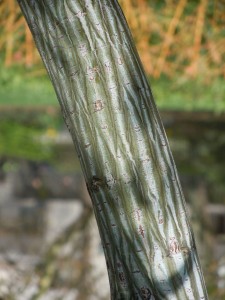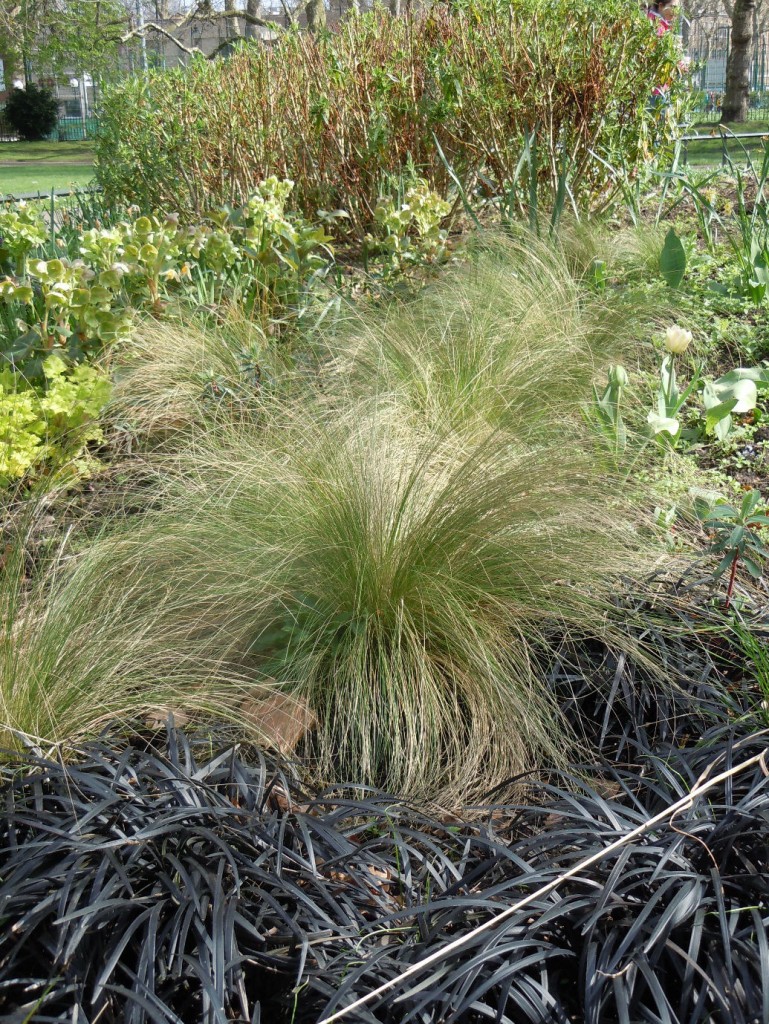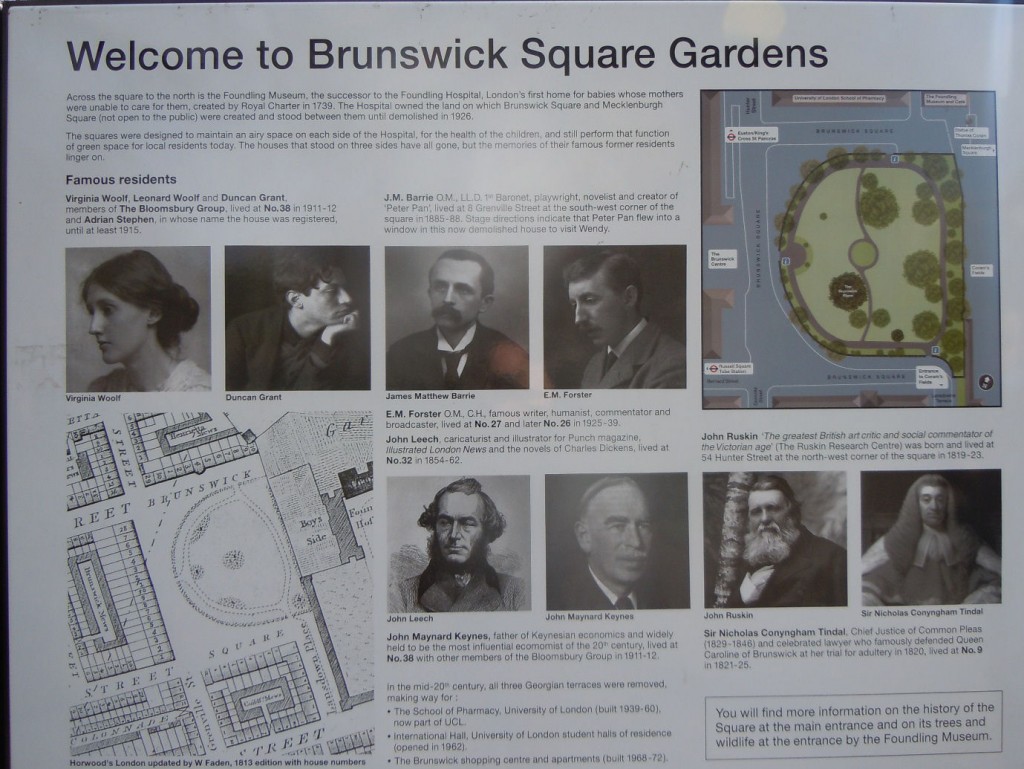I have been very fortunate during my career to have worked in many parts of London. In fact, it’s a great way to get to know certain areas; the cultural feel of these places, and the lingering unique impressions which stay with you. The tight, regimented orderliness of the City; the looser, happy-high scene of the West End; the eclecticism of Bankside, and so on. I spent many years working in Bloomsbury and have studied in many of the colleges there. Of course, with Senate House sitting Orwellian-like at its very core, Bloomsbury feels very much like a university town: annexed colleges, serious-looking students, bicycles and dusty bookshops. I always feel like a proper scholar when walking those streets!
To reach Brunswick Square, take a gentle walk up from the West End – perhaps even cutting through the wind-tunnel lobby of Senate House. Carry on through to Russell Square, another of London’s lovely green lungs, then continue towards the now revamped shopping area of Brunswick Centre and suddenly you arrive!
Situated in the heart of Bloomsbury, Brunswick Square is one of many historic squares and gardens to be supported by the umbrella group, the Association of Bloomsbury Squares & Gardens. Brunswick Square is part of the huge Bedford Estate, which is certainly not short of green spaces in and around Bloomsbury – Gordon, Bedford, Tavistock, and Torrington Squares, to name just a few!
Dating back to the 1790s, Brunswick Square was created on land sold off by the cash-strapped governors of the Foundling Hospital: the idea being to bring a rural aspect, as well as some much-needed fresh air, to the child patients. Originally, and similar to many other London garden squares, Brunswick was designed to act as a kind of transition site, bridging the gap between town and country, to allow views out and into the rural landscape beyond London. As mentioned on one of the excellent display boards situated around the square, the original designers wished to ‘retain a sense of openness’ around the hospital. Over 200 hundred years later, that sense of openness and space is still a major feature of one’s sensory experience within the square.
The square was named after Queen Caroline of Brunswick, with the surrounding Georgian terraces designed by James Burton (1761 -1837), purported to be ‘probably the most significant builder of Georgian London’. Housed within the respectable, if not always fashionable, boundaries of Bloomsbury, Brunswick Square – along with the other nearby squares – certainly gives you a feel that London ‘proper’ is now somewhat behind you, and that here’s a good place to rest shop-weary legs!
Famous residents of the area include the obvious ‘Bloomsberries‘ (Virginia Woolf, Vanessa Bell, Duncan Grant etc), as well as the economist John Maynard Keynes; the writers J. M Barrie (author of Peter Pan) and E.M Forster; the social commentator John Ruskin, as well as John Leech, Charles Darwin, Charles Dickens. The list goes on and of course includes the suffragist Millicent Garrett Fawcett and her friend and neighbour Fanny Wilkinson, who was the first female professional garden designer in the England, who worked for the MPGA and designed over 70 gardens in London.
In 2002-2003 the gardens at Brunswick Square were extensively refurbished by Camden Council, including the restoration of the iron railings which were removed during the Second World War and made into wartime ammunition. Camden Council still help to maintain the garden, taking care of the heavy work of grass and hedge cutting, as well as looking after the trees and maintaining the large central bed.
A great deal of good work has been done by the Friends of Brunswick Square set up in 2008. Chair of the Group is Elizabeth Stanton Jones, who provides a power-house of support and passion for the work that goes on there. Elizabeth first contacted the MPGA in 2015 on hearing about their Bulbs for London campaign. As a result, over 1500 bulbs were received at the Square – fortunately the day before a volunteer session was due to take place. That’s a lot of bulbs to plant!
Two beds ‘horribly-filled with ivy’ were quickly cleared by the volunteers and are now filled with beautiful bulbs from Taylors, organised by the MPGA. As Elizabeth says, the difference made in just those two beds the following Spring caused a ‘notable and heart-warming’ reaction to many users of the park and ‘it made all the difference’.
Brunswick Square now has a well-attended volunteer gardening group who meet once a month on Saturdays mornings, working in the various beds and borders. They have also taken back the once ‘hedge-hogged’ shrubs, now pruning them as to their want and habit; releasing them from their council blobbing! The Friends and volunteers of the square also assist with much-needed fundraising. This goes towards financing an experienced and historically-aware professional gardener, Stephen Smith, to help lead the work, which pays ‘great dividends in terms of training, planning and risk assessments.’
Like almost every similar square in London, Brunswick has to plant its beds and borders with shade in mind, yet it manages to do this in a very creative, often lush and exuberant way. Walking around the garden in April as I did, one is exposed to a rich tapestry of planting form, texture and colour. The waxy leaves of a Griselinia hedge acts as the perfect foil to the fine coppery bark of a specimen Prunus Serrula. The waving, pony-tale hairs of Stipa tenuissima fall gently onto the black blades of Ophiopogon ‘Nigrescens’.
There are also some great specimens of Camellia – flowering profusely at the time of my visit – as well as many Hebes and fine, healthy-looking shrubs such as Viburnum davidii, Kerria japonica.
 |
 |
The snake-like bark of Acer capillipes
Some gorgeous ground-covering was being served up by the soft leaves of several lazy Bergenia, blissful Brunneras and excited Epimediums. A central bed houses three very distinctive and incredibly architectural Snake Bark Maples (Acer capillipes), all underplanted in a very inventive and imaginative way.
However it is those huge Brunswick Plane trees which give the garden its sense of volume and scale. One in particular Platanus x acerifolia, believed to be over 200 years old, is the second oldest London Plane tree and one of London’s ‘top ten’ trees!
The gardens at Brunswick Square are a shining example of how a community space can be managed successfully. A keen and regular volunteer gardening group; a strong and supportive network of friends; heavy labour provided by the council, plus assistance from various funding bodies… and of course, many (many!) bulbs supplied by Taylors through the MPGA!
All those occupied in the upkeep of the Square have the same aim: ‘promoting the enjoyment, and safe use of the gardens’ as well as ensuring that ‘improvements are made in keeping with the character of the square and its history’. This means that the Square continues to be an oasis of green enjoyment and calm – it certainly keeps all those involved busy!
Do go and see Brunswick Square for yourself and whilst there go and hunt for Tracy Emin’s child’s glove, a nod to the children of Thomas Coram’s Foundling Hospital.
Marc Owen







